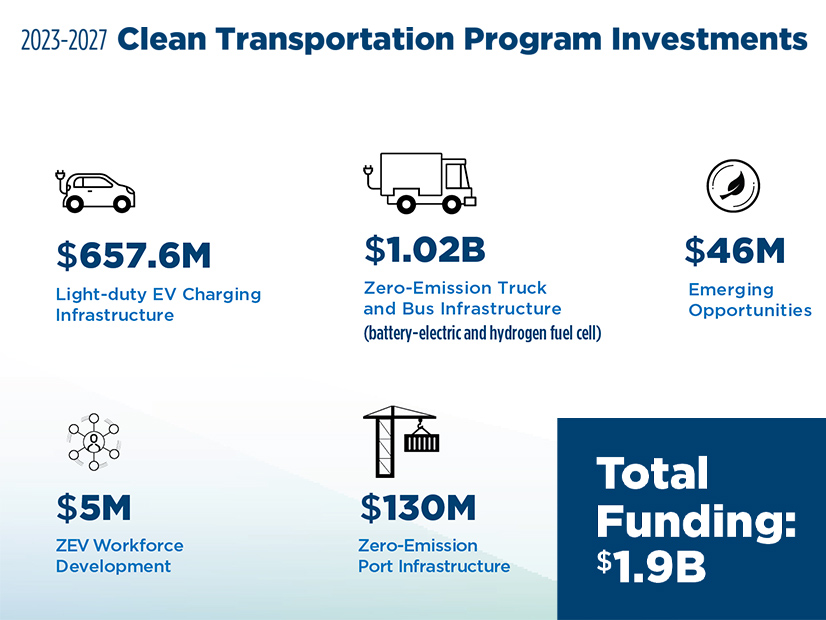
The California Energy Commission approved a plan for spending $1.85 billion over the next four years to expand zero-emission vehicle infrastructure across the state.
The California Energy Commission approved a plan for spending $1.85 billion over the next four years to expand zero-emission vehicle infrastructure across the state.
The bulk of the money — $1.15 billion — will go toward infrastructure for medium- and heavy-duty ZEVs. That includes $130 million for zero-emission infrastructure at ports. The funding is for battery-electric charging as well as hydrogen fueling.
For light-duty vehicles, the plan includes $658 million for ZEV infrastructure.
The commission approved the investment plan for the Clean Transportation Program during its Feb. 14 business meeting.
At least half of the money in the investment plan will be used to benefit disadvantaged communities.
“We need to make sure that this is zero-emission refueling infrastructure for everybody,” said Commissioner Patty Monahan, the CEC’s lead commissioner for transportation.
ZEV infrastructure is needed for residents of multifamily dwellings, rural areas, and dense places “that are suffering disproportionately from air pollution,” Monahan said in a statement after the vote.
Monahan also noted that funding figures could change based on the state budget. (See Newsom Budget Would Trim Calif. Climate Spending.)
“As we all know, this is a tough budget year,” she said during the commission’s meeting.
Funding Sources
Funding in the investment plan comes from three sources: the state general fund; the Greenhouse Gas Reduction Fund (GGRF), which gets money from the cap-and-trade program; and the Clean Transportation Program, which is funded through a surcharge on California vehicle registration.
For example, the plan allocates $230 million in GGRF money over four years for zero-emission drayage truck infrastructure. Electric school bus infrastructure will receive $125 million in each of the next three years from the general fund.
The investment plan divides funding into general categories, with details of the programs to be worked out through the CEC’s solicitation process.
In addition to funding for light-, medium- and heavy-duty ZEV infrastructure, the plan allocates $46 million for “emerging opportunities” in areas such as aviation, marine vessels and rail. And $5 million will go toward workforce training.
The plan’s emphasis on infrastructure for medium- and heavy-duty ZEVs is due to the outsized impact conventional trucks have on air quality, the CEC said.
Trucks account for roughly 2% of the 31 million vehicles registered in California. But they’re responsible for about 23% of on-road greenhouse emissions, as well as large shares of nitrogen oxides and particulate matter from the transportation sector.
“For these reasons, medium- and heavy-duty vehicles represent a significant opportunity to reduce GHG and criteria emissions while focusing on a small number of vehicles,” the investment plan states.
EV Charging Needs
California will require all new cars sold in the state to be zero emission by 2035. The state’s Advanced Clean Trucks and Advanced Clean Fleets regulations set timelines for transitioning medium- and heavy-duty trucks to zero emission.
The CEC released a report in August projecting that the state will need about 1 million public or “shared private” chargers in 2030 to support 7.1 million plug-in electric cars. By 2035, the numbers are expected to grow to 2.1 million public or shared chargers needed for 15.2 million light-duty plug-in EVs.
Currently, California has close to 94,000 public and shared private chargers, in addition to private chargers at homes and other locations. The CEC said in a release that funding in the new investment plan will result in about 40,000 new chargers across the state.
Funding from other programs also will boost ZEV infrastructure. For example, the state is expecting to receive $384 million in federal funding through the National Electric Vehicle Infrastructure (NEVI) program.
“Combined with previous investment plans, funding from the federal government, utilities and other programs, the state expects to reach 250,000 chargers in the next few years,” the CEC said.


